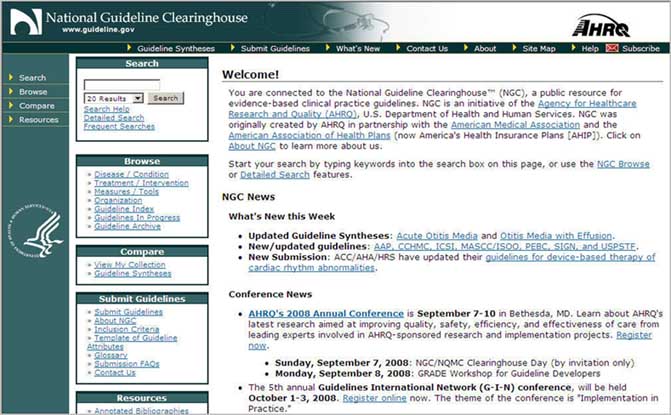Evidence-Based Public Health Resource Review:
Monday, June 30th, 2008National Guideline Clearinghouse
Evidence-Based Practice Guidelines
Submitted by Hathy Simpson
The National Guideline Clearinghouse (NGC) (http://www.guideline.gov) is a free online resource for evidence-based clinical practice guidelines and related documents. Most guidelines have a clinical focus towards treating individual patients, but many guidelines can be applied to population-based public health practice. A benefit of NGC is that it includes guidelines developed by U.S. and international organizations including government agencies, professional societies, and private organizations. Updated weekly with new content, the NGC is produced by the Agency for Healthcare Research and Quality (AHRQ), U.S. Department of Health and Human Services.

Key Features of the Clearinghouse:
- Structured, standardized abstracts about each guideline and its development.
- A guideline comparison tool for comparing attributes of two or more guidelines.
- Links to full-text guidelines when available and ordering information.
- PDA downloads of summaries.
- Guideline Syntheses, synthesis of guidelines covering similar topics, highlighting areas of similarity and differences. For example, how do the recommendations for mammography screening from the American Cancer Society differ from the American College of Obstetricians and Gynecologists?
- Expert Commentary, perspectives written and reviewed by editorial board members. For example, a recent commentary is about practice guidelines on eating disorders.
- What’s New, an update on what guidelines have been added each week.
- NGC Update Service, a weekly electronic mailing of new guidelines and updates to existing guidelines.
Searching Options
- Browse – Scan guidelines available by disease/condition, treatment/intervention, or organization. For example, view all guidelines developed by the Centers for Disease Control and Prevention (CDC).
- Basic Search – Enter a search term to quickly search the database.
- Detailed Search – Use to limit search by attributes such as guideline category, publication date, intended users, or target population. For example, to search for population-based public health guidelines on reducing the prevalence of obesity in adolescents, select “Prevention” under guideline category and limit the age of target population to “Adolescent.”


Search Results
- Citation (title, source, date, etc.).
- Guideline status – current status and previous releases.
- Brief summary with a link to the complete summary of the guideline.
- Recommendations with evidence ratings if available.
- Evidence supporting recommendations – please note that an “inconclusive” or “lack of sufficient evidence to determine effectiveness” does not mean a strategy does not work. It means that there is not enough research evidence to determine if the strategy works or not.
- Guideline developers, source of funding, and names of committee members.
- Links to full-text guidelines (if available for public access), ordering information, and links to related documents.
- Patient resources if available.
The National Guideline Clearinghouse is available on the Evidence-Based Practice for Public Health website, http://library.umassmed.edu/ebpph/ under “Evidence-Based Guidelines.” If you have any questions, comments, or interest in a demonstration of evidence-based resources for public health practice, please contact me.
Hathy Simpson, Public Health Coordinator
hathy.simpson@umassmed.edu




